Extraordinary and exotic: Why now is the time to visit South America
By Chris Moss and Julietta Jameson

The majestic Vinicunca in the Cusco region of Peru, also known as Rainbow Mountain.Credit: iStock
South America’s landscape is otherworldly. The Patagonian Andes, Ecuador’s cloud forests, the Pantanal and Pampas are immense areas where 500 years of “development” have not wiped out flora or fauna.
The Amazon basin, which spreads over more than a third of the landmass and eight of South America’s 12 countries, is a peerless biodiversity hotspot.
South America’s human geography is equally enthralling. The tapestry is complex and the art, music, cuisine and other cultural expressions are mestizo (mixed), like many people’s ethnic inheritance.
The continent’s Italian and Spanish-inflected cuisines, colonial-era churches and modern metropolises can feel familiar but fascinating for existing far from their origin.
A trip into rural areas permits contact with indigenous-dominant groups, which can be instructive when well managed. Pre-Columbian ancient sites and syncretic Christianity and local beliefs are very much on show.
The lingua franca across all the nations except Brazil and the Guianas is Spanish, making travel straightforward. But don’t expect homogeneity – the delights of South America lie in the nuances, differences and imprecise borderlands of national character.
Each country has its own USP (marketing speak for “unique selling proposition”). For this beginners’ guide, we’ve highlighted the big-hitting regions, cities and sites. Argentina, Brazil and Chile continue to be favourites with travellers, beach-lovers and those who want a little luxury.
Peru and Bolivia have long appealed to archaeology fans, walkers and backpackers. Paraguay, Uruguay and the Guianas are more offbeat but on the rise.
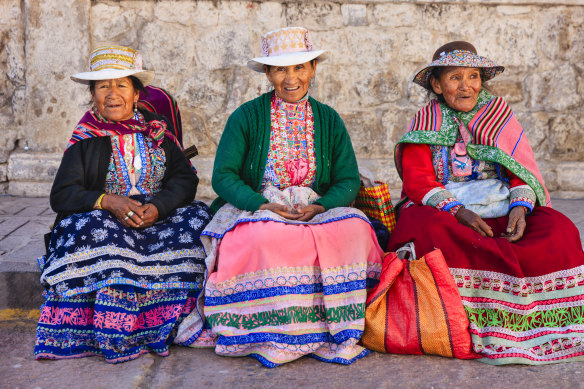
Residents of the Colca Valley, Peru.Credit: Getty Images
For Australians, now’s a good time to consider a South American holiday, particularly since LATAM Airlines, the Chilean flag carrier, has just relaunched its direct service between Sydney and Santiago, the capital of Chile with the Melbourne to Santiago direct route increasing to four times a week from next month.
The most egregious impacts of the pandemic have receded and the great parks and trails – including the perennially popular Machu Picchu – are fully open.
The recent political turbulence in Ecuador has largely eased, and the government has green-lit the interior and the Galapagos Islands.
The cost-of-living crisis has affected all countries, but South America remains better value than, for instance, most of Europe – especially if you steer clear of the ultra-high-end hotels. Here, then, is a beginner’s guide to travelling in and around this extraordinary and exotic continent of extremes.
Argentina + Chile
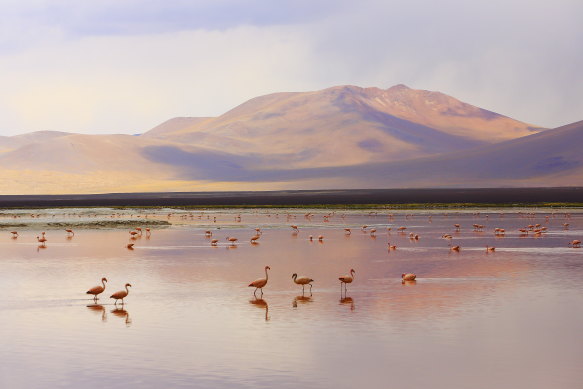
Surreal landscape of the Atacama Desert.Credit: Getty Images
These two large countries at the southern tip of the continent deserve their own entries, but are doable as a double act, whether you opt for a Patagonian odyssey or the sultrier climes of the Andean regions of the north.
Buenos Aires is romantic and frantic with one foot in Europe and the other in Latin America. Almost all international flights touch down here, and a few days to unwind and stroll around the streets – with stops at old cafes, bars and steakhouses – is obligatory.
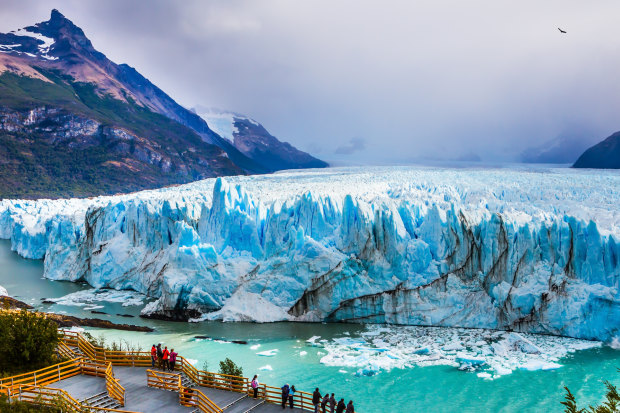
The expanding Perito Moreno glacier in the Argentine part of Patagonia. Credit: Getty Images
Other standouts are the Iguazu Falls – shared with Brazil, but closer and louder on the Argentinian side – colonial Salta and the wine region around Cafayate; the Parque Nacional Los Glaciares (a UNESCO World Heritage Site and home to the expanding Perito Moreno Glacier), and the Pampas, with their serene estancias, where you can find your inner gaucho on horseback or in a hammock.
Chile has one of South America’s most visited national parks – Torres del Paine National Park – where the 10-day circuit around the base of the massif is one of Patagonia’s greatest hikes. At the other extreme is the Atacama Desert, where the clear skies and unpolluted atmosphere draw the world’s astronomers.
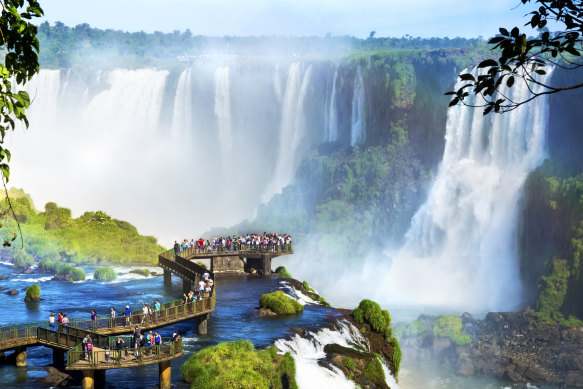
The Iguazu Falls, one of the world’s great natural wonders, on the border of Brazil and Argentina. Credit: iStock
The wineries in the suburbs of Santiago are some of the oldest in South America and it’s easy to combine a visit to the capital with a stay in Valparaiso, a more atmospheric, artsy city known for its associations with Pablo Neruda, Chile’s most celebrated poet.
The Lake District is home to German settlers, Mapuche Indians and eco-conscious exiles from Santiago, while Tierra del Fuego is where cruises head off into the glacier-walled fjords.
Where to stay
In Buenos Aires, the recently opened Hotel Casa Lucia (hotelcasalucia.com; doubles from $512) is housed inside the former Palacio Mihanovich. Legado Mitico (legadomitico.com; doubles from $453) is a great base for exploring the local bars and restaurants.
The Singular Santiago (thesingular.com; doubles from $393) is set in the Chilean capital’s hippest area; the same company owns one of Patagonia’s landmark hotels – Singular Patagonia (doubles from $449) – which occupies a former cold-storage warehouse on Last Hope Sound.
Colombia + Ecuador
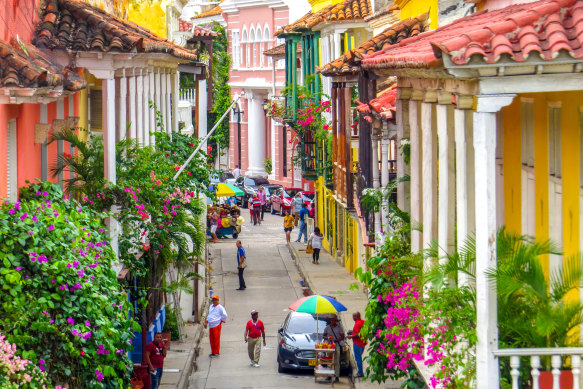
Vibrant streets of walled city Cartagenca in Colombia.Credit: Getty Images
Beautiful, balmy, mountainous Colombia – the only South American country to boast both Caribbean and Pacific coasts – is now firmly on the mainstream bucket list.
It’s one of the world’s best countries for birdwatchers, with 1800 species, 76 of which are endemic. Natural reserves such as Cerro Montezuma and the Tayrona National Natural Park are great choices for effortless birding.
The most emblematic region is the “eje cafetero” or “coffee axis”, formed by the towns of Armenia, Manizales and Pereira, where tropical vegetation, coffee plantations and the Andes – which split into three separate chains here – conjure images from the pages of Gabriel García Marquez’s One Hundred Years of Solitude.
In the provincial capitals, choose from salsa classes in Cali, architecture tours in Medellin and colonial treasures in the small towns of Santa Cruz de Mompox, Barichara, Villa de Leyva, Salento, and Santa Fe de Antioquia. Colombia also has two tourism-friendly Caribbean islands: sophisticated San Andres and English-speaking Providencia.
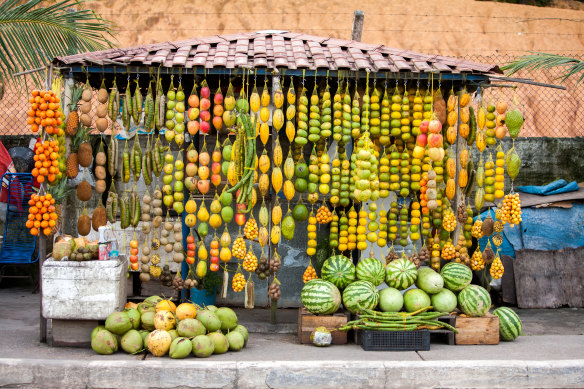
Take stock … Amazonian fruit stall.Credit: iStock
Ecuador has experienced a lot of political strife since the pandemic. Things are calmer now and improving every day. Once the northern outpost of the Inca empire, it can’t match countries further south for archaeological show-stoppers, but it makes up for that with natural wonders.
These include the Avenue of the Volcanoes, a road through two rows of parallel, snow-capped peaks; an Amazon jungle region that is easy to access; the cloud forest reserve of Mindo for wildlife, orchids and other rare flora; and the Galapagos Islands – best explored by small ship – with their world-famous boobies, tortoises, sea turtles and marine iguanas.
Where to stay
Mashpi Lodge (mashpilodge.com; doubles from $1930 a night) is a glass-walled architectural statement inside its Ecuadorian forest reserve. Pikaia Lodge (pikaialodge.com; from $8036 a person for a three-night “adventure” package) is the first luxury property to open in the Galapagos. Sofitel Santa Clara (all.accor.com; doubles from $1272) in Cartagena, Colombia, sprawls over a 17th-century monastery, with crypts, wells, confessionals and art galleries open to guests.
Peru + Bolivia
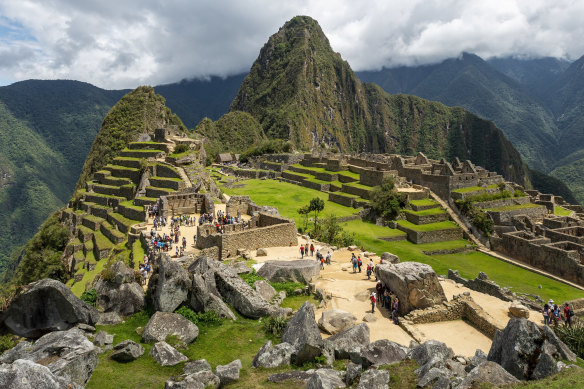
Drawcard of the ages … Machu Picchu. Credit: Getty Images
Lima was the de facto capital of Spanish South America and nearby Callao its key port. Today the Peruvian capital is a heady place to explore the long history of indigenous civilisations and colonial conquest. The Huaca Pucllana is an impressive ceremonial centre in the heart of residential Miraflores.
Away from the capital, Cuzco is the other must-stay city because, while it’s backpackerville, it has some of the most impressive monasteries, churches and pre-Columbian buildings in South America. Nearby is the Sacred Valley – easily traversed by train – and the superlative archaeological site of Machu Picchu.
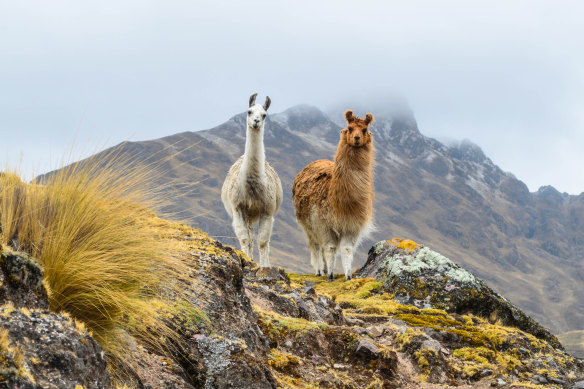
High point … wild llamas wandering the mountains of rural Peru.Credit: iStock
Iquitos is the sultry base for a cruise around the headwaters of the Amazon and the Pacaya Samiria National Park. In the Cordillera Blanca, tough hikers can ascend to tropical glaciers and turquoise lakes. The mysterious, geometrical Nazca Lines, thought to have been etched into the stony desert as far back as 900 BC, make for a less arduous stopover.
High-altitude Bolivia takes visitors’ breath away, literally. The capital La Paz, at 3650 metres above sea level, is bustling, colourful and shabbily atmospheric – though the suburb of Zona Sur is now modern and relatively affluent.
The colossal Illimani mountain is the city’s backdrop, and a trip into the Andes is worth the effort. Highlights include colonial Potosi, with its silver mine in the Cerro Rico and the local mint, converted into one of South America’s best museums; the Star Wars landscapes of the Uyuni salt flats, best explored by four-wheel drive; the islands of Lake Titicaca; and the UNESCO-listed archaeological site at Tiwanaku, home to an important precursor of the Inca civilisation.
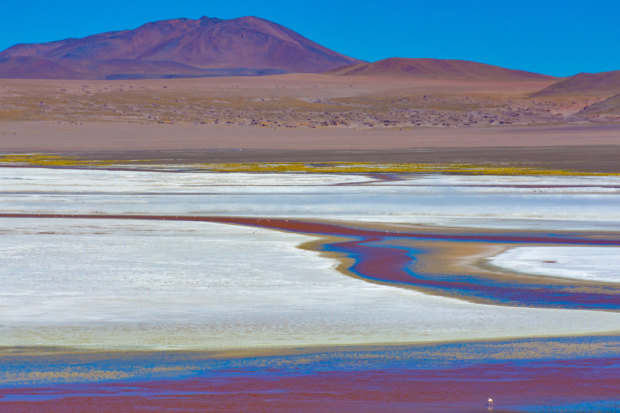
Extraterrestrial landscapes of the Uyuni salt flats.Credit: Getty Images/iStockphoto
Where to stay
The Palacio del Inka (marriott.com; doubles from $584) in Cuzco is where 16th Spanish conquistador, Francisco Pizarro’s brother and fellow conqueror, Gonzalo, once resided. The Palacio Nazarenas (belmond.com; from $1270 a night,) occupies a restored 17th-century palace and convent. Hotel B (hotelb.pe; doubles from $508) is Lima’s most beautiful hotel, offering five-star service in an intimate, palatial setting. In La Paz, Casa Grande (casa-grande-hotel.coml doubles from $229) is the most stylish option in Zona Sur.
Brazil
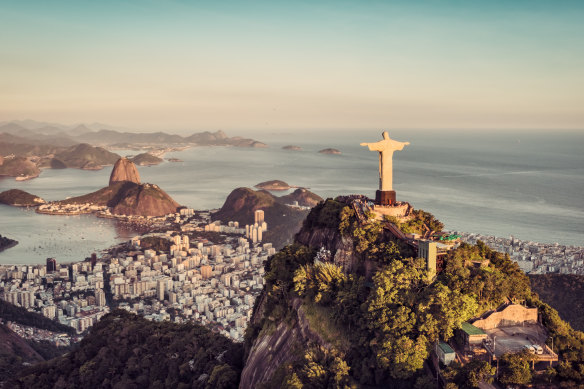
Sugar Loaf Mountain and Botafogo Bay, Rio de Janeiro.Credit: iStock
Brazil is not only different from its neighbours because of its size and language – Portuguese rather than Spanish. It also has a very different topography – mainly low-lying, tropical and dominated by the Amazon basin.
Its human geography is profoundly enriched by African history and connections. Brazil achieved independence not through a republican movement but thanks to a prince who liked the beach.
In 1808 Rio de Janeiro became the imperial capital, with King John VI and his son, Dom Pedro, in residence. Today it’s arguably the global capital of beach culture and for first-time visitors, a few days in Ipanema or Copacabana make for a wonderful welcome.
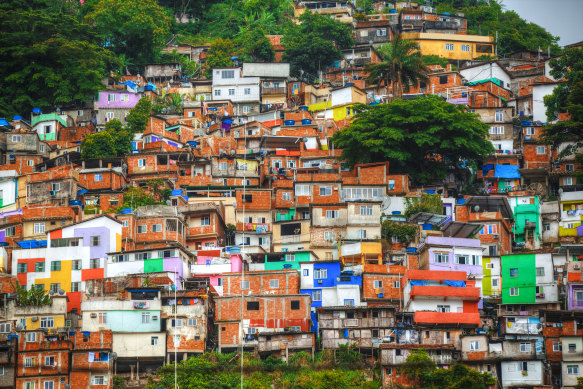
Colourful favela homes in Rio de Janeiro.Credit: Getty Images
The city’s Carnival is rightly world-famous, though Salvador’s is more of a people’s party. Other highlights include Brasilia’s modernist architecture, Sao Paulo’s art and gastronomy and the wildlife of the Pantanal wetlands, where South America’s “Big Five” can be seen.
Another highlight, of course, is the Amazon. Best seen from a riverboat and the surreal dunes and lagoons of the Lencois Maranhenses, it was recently declared a UNESCO World Heritage Site. Brazil is immense, and you’d need three or four visits, at least, to say you had a sense of its scale and diversity. But a well-curated tour can be a fulfilling taster.

Wild at heart … a toucan in Brazil.Credit: Getty Images/iStockphoto
Where to stay
The Rosewood Sao Paulo (rosewoodhotels.com; doubles from $906) is a luxurious hotel and local meeting place In Rio, you’re spoilt for choice: there’s the super-stylish Fasano (fasano.com.br; doubles from $1046), legendary Copacabana Palace (belmond.com; from $885 a night) and Santa Teresa RJ MGallery (all.accor.com; doubles from $674). In the Pantanal and Amazon, the Uakari Lodge (uakarilodge.com; three-night package from $1202 a person), sits on a tributary of the Solimoes (Brazil’s Upper Amazon) near Tefe.
The details
Fly
LATAM Airlines (latamairlines.com) flies direct between Sydney and Santiago, Chile four times a week. Melbourne to Santiago flights will increase to four times a week from December 4. Distances within South America are generally long with flying the quickest and cheapest way to get around. The excellent and affordable regional network includes LATAM, Avianca (avianca.com), Aerolineas Argentinas (aerolineas.com.ar), Azul (voeazul.com.br) and Gol (voegol.com.br) as well as no-frills operators such as Sky (skyairline.com), Flybondi (flybondi.com), with “bondi” being Argentinian slang for “bus” and Jetsmart (jetsmart.com)
Drive
Hiring a car is recommended for big highway-themed holidays, such as Argentina’s Ruta 40 or the Costa Verde in Brazil. Rates vary across countries but budget about $96 a day for a small car; all the main rental firms are present in capitals and airports. Hire a driver if you’re heading for the wilds. Rail travel is limited following decades of closures, but Peru has good long-distance lines through scenic areas.
When
The shoulder months of October to November and March to April are ideal for Argentina and Chile while other countries are subtropical. That means it’s never cold and the weather has more to do with altitude and topography than time of the year. The Brazilian Amazon has major rains from December to May; the period after this – the flooded season – is a good time to explore the upper Amazon. The Andean dry season is between May and October, but this also means high demand for Peru and Bolivia. It rarely rains in the Atacama Desert of northern Chile.
Tour
Bunnik Tours (bunniktours.com.au) has a 26-day South America In-Style holiday from $33,595 a person, visiting Brazil, Argentina and Peru; Chimu Adventures’ (chimuadventures.com) has a nine-day Signature Ecuador – Quito to Guayaquil trip from $5473 a person; APT’s (aptouring.com.au) 19-day Best of South America tour journeys from Santiago, Chile to Cusco, Peru, incorporating the highlights of Peru, Brazil, Chile and Argentina from $17,995 a person for 2025 departures.
South America: What to know before you go
Pack
Plan for rain as well as heat. Both the Andean regions and parts of the Amazon are shower-prone, whatever the season. A hat, sunglasses, sunblock and binoculars for birdwatching, are essential, as are light clothes. Panama hats are made in Ecuador.
Visas
Generally, a passport with six months’ validity is all you need for a 90-day stay in South American countries, with the visa issued on arrival, but check well before departure. Some airports charge a departure tax so be prepared.
Timing
Book your South American sojourn as far in advance as possible, especially for major attractions. Demand is generally highest from December to March with Chileans and Argentines flocking to their lake districts and beaches over Christmas and January.
Society
South America is characterised by a small percentage of extremely rich people and tens of millions of extremely poor people. First-time visitors will notice that the historic centres of the continent’s major cities suddenly give way to dirt-poor residential barrios.
Security
Opportunistic rather than violent crime is quite common throughout South America with foreign tourists standing out when their expensive cameras, smartphones and sunglasses are on display. Kidnapping of tourists for ransoms, notably in Colombia, while rare, does regrettably occur.
This adapted article originally appeared in the travel section of the Telegraph UK.